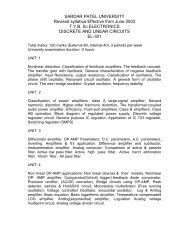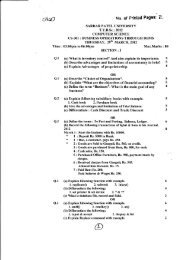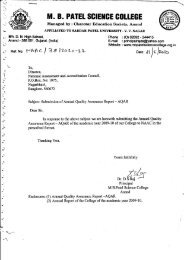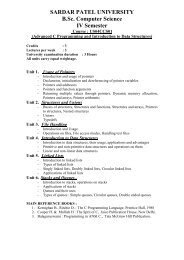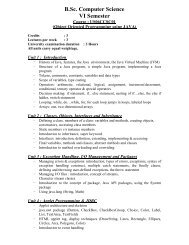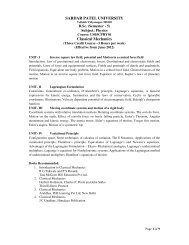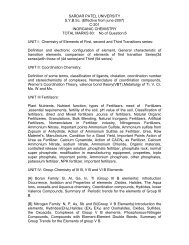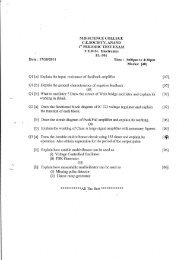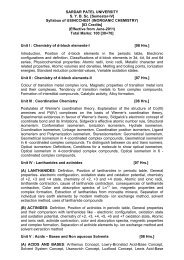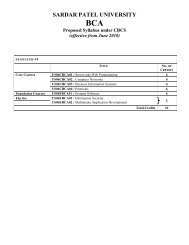SARDAR PATEL UNIVERSITY VALLABH VIDHYANAGAR S- 201 ...
SARDAR PATEL UNIVERSITY VALLABH VIDHYANAGAR S- 201 ...
SARDAR PATEL UNIVERSITY VALLABH VIDHYANAGAR S- 201 ...
- No tags were found...
Create successful ePaper yourself
Turn your PDF publications into a flip-book with our unique Google optimized e-Paper software.
<strong>SARDAR</strong> <strong>PATEL</strong> <strong>UNIVERSITY</strong><strong>VALLABH</strong> <strong>VIDHYANAGAR</strong>S- <strong>201</strong>PROBABILITY & DISTRIBUTION THEORY(Effective from June 2003)No. of Lectures per week: 3 External Marks: 80Internal Marks: 40Total Marks: 120University Exam duration 3 hoursUnit 1:Revision(Random Experiment, sample point and sample space, event,operations of events, concepts of mutually exclusive and exhaustive events.)Definition of probability: classical and relative frequency approach, axiomaticdefinition of probability. Discrete probability space, properties of probability,independence of events, conditional probability, total and compound probabilityrules, Bayes’ theorem and its application. General probability space: Sigmaalgebra of events.Unit 2:Discrete and continuous random variable (rv); probability mass function(pmf), probability density function (pdf), Cumulative distribution function (cdf)and its properties. Joint pmf/pdf of several random variables. Marginal andconditional pmf/pdf. Independence of random variables.Unit 3:Expectation of a random variable and its properties. Moments, measure oflocation, dispersion and quantiles of a random variable. Probability generatingfunction (pgf), moment generating function(mgf) and cumulants generatingfunction (cgf) of a random variable, their properties and uses.Unit 4: Discrete DistributionStandard univariate discrete distributions: Degenerate, Uniform, Binomial,Hypergeometric, Poission, Geometric and Negative Binomial distribution. Mean,Variance, mgf, pgf, and cgf of standard distribution.Unit 5: Continuous DistributionStandard univariate continuous distributions and their properties : Uniform,Beta, Gamma, Exponential, Normal; Moment Generating function (mgf); itsproperties and applications.
Unit 6:Normal distribution as a limiting case of Binomial and Poission distribution.Sampling distribution of sample mean for normal and sample total for Binomial,Poission, Negative Binomial, Normal and Gamma distributions. Chi-square, tand F distribution as distributions of functions of standard normal randomvariables.Syllabus:1) Fundamental of Mathematical Statistics: S. C. Gupta & V. K. Kapoor2) Fundamental of Statistics: S. G. Gupta3) Fundamental of Applied Statistics: S. C. Gupta & V. K. Kapoor
S-202DESCRIPTIVE STATTISTICS(Effective from June 2003)No. of Lectures per week: 3 External Marks: 80Internal Marks: 40Total Marks: 120University Exam duration 3 hoursUnit 1:Types of Data: Concepts of a statistical population and sample from apopulation; qualitative and quantitative data; nominal and ordinal data; crosssectional and time series data; discrete and continuous data; frequency and nonfrequencydata. Different types of scale – nominal, ordinal, ratio and interval.Collection and Scrutiny of Data : Primary data – designing a questionnaire and aschedule; checking their consistency. Secondary data – their major sourcesincluding some government publications. Complete enumeration, controlledexperiments, observational studies and sample surveys. Scrutiny of data forinternal consistency and detection of errors of recording, Ideas of crossvalidation.Unit 2:Presentation of Data: Construction of tables with one or more factors ofclassification. Diagrammatic and graphical representation of non-frequency data.Frequency distributions, cumulative frequency distributions and their graphicaland diagrammatic representation – column diagram, histogram, frequencypolygon and ogives. Stem and leaf chart. Box plot.Unit 3:Analysis of Quantitative Data: Univariate data: Concepts of central tendency orlocation, dispersion and relative dispersion, skewness and kurtosis, and theirmeasures including those based on quantiles and moments. Sheppard’scorrections for moments for grouped data ( without derivation ). Measures ofinequality – Gini’s coefficient and Lorenz curve.Unit 4:Bivarate data : Scatter diagram. Product moment correlation coefficient and itsproperties. Coefficient of determination. Correlation ratio. Concepts of regression.Principles of least squares. Fitting of linear and quadratic regression and relatedresults. Correlation index. Fitting of curves reducible to polynomials by log andinverse transformation. Rank correlation-Spearman’s and Kendall’s measure.
Unit 5:Analysis of categorical data : Consistency of categorical data. Independenceand association of attributes. Various measures of association for two- way andthree – way classified data. Odds ratio.Scaling of data: Motivation for scaling. Measurement for psychological traits.Scaling of items according to difficulty. Scaling of test scores. Scaling of ratesand ranks. Scaling of judgment.Unit 6: Economic StatisticsTime series analysis – Economic time series, different components, illustration,additive and multiplicative models, determination of trend, growth curves,analysis of seasonal fluctuations, construction of seasonal indices.Analysis of income and allied distribution – Pareto distribution, graphical test,fitting of Pareto’s law, illustration, log-normal and its properties, Lorenz curve,Ginny’s coefficient.Syllabus:4) Fundamental of Mathematical Statistics: S. C. Gupta & V. K. Kapoor5) Fundamental of Statistics: S. G. Gupta6) Fundamental of Applied Statistics: S. C. Gupta & V. K. Kapoor
OR-211OPERATION RESEARCH(Effective from June 2003)No. of Lectures per week: 3 External Marks: 80Internal Marks: 40Total Marks: 120University Exam duration 3 hoursUnit 1:Linear Programming : Mathematical formulation of the problem. Definition offeasiblesolution , basic solution , basic feasible solution. Solution of linearprogramming problem ( lpp) by graphical method.Unit 2:Simple algorithm and its application to simple Linear programming problem.Dual problem and its solution.Unit 3:Transportation problems (including unbalanced and degenerate cases) : Initialfeasible solution by the methods of North – West Corner, Inspection, Vogel ,stepping stone. U- V method for finding the optimal solution.Assignment Problems : Hungarian method of solving it.Unit 4:Simple Inventory models. Economic lot size formula with shortage and withoutshortage for deterministic models.Unit 5:Queuing Theory : Concept of Queuing. Characteristics of queuing process.Poisson process, Distribution of inter-arrival times. Classification of queues.M/M/1 queuing process : Model, characteristics of the model, waiting timedistribution for the model and its characteristics, Examples.
Unit 6:Elements of Game Theory : Two person zero sum game : concepts , saddlepoints.Games without saddle points- mixed strategies ( Result without proof ).Graphicalsolution of 2 x n and n x 2 games. Dominance property.Books Recommended :__________________1. Kanti Swarup and Man Mohan Gupta :2. Loomba, N. Paul : Linear Programming3 Saseini, Yaspan and Friedman : Operation Research : Methods andProblems4 Chuchman, Ackoft, Arnoft : Introduction to Operation Research.
S-203Statistics practicals(Effective from June 2003)(Two Practicals each of 3 hours duration and of 40 marks)Practical – IPascal ProgrammingGiven a data { ( x 1 , f 1 ), ……….., ( x n , f n )} to write algorithm, to preparePASCAL Programme for computing and to verify on computers.1. (i) Sample mean (ii) Sample median (iii) Sample mode (iv) Sample quartiles(v) Sample octiles (vi) Sample deciles (vii) Sample percentiles.2. (i) Sample range (ii) Sample mean deviation (iii) Sample standard deviation(iv) Sample coefficient of dispersion (v) Sample coefficient of variation.3. (i) First four sample moments (ii) Sample coefficient of skewness(iii) Sample coefficient of kurtosis.Given a data { ( x 1 , y 1 ), ……….., ( x n , y n )} to write algorithm, to preparePASCAL Programme for computing and to verify on computers.4. The least square estimates of unknown constant in fitting(i) y = a + b x + e (ii) y = a + b x + c x 2 + e(iii) y = a x b + e (iv) y = a b x + e5. (i) Sample correlation coefficient (ii) Sample rank correlation coefficient (iii)The regression coefficients.Practical – IIManual1. Fitting of(i) Binomial distribution (ii) Negative Binomial distribution (iii) Poissondistribution(iv) Normal distribution (v) Uniform (vi) Exponential distribution.2. Testing of hypothesis using Z, Chi-square, t and f.3. Time series Analysis : To determine trend and seasonal fluctuations by usingthe following methods.Trend: (i) Freehand curve method (ii) Moving Average method (iii) usingmathematical curves.



